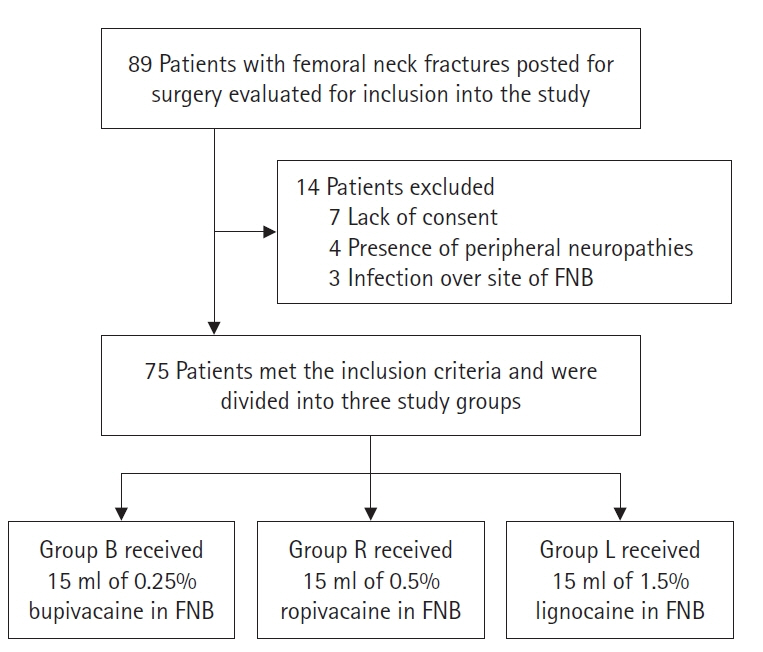Acute Crit Care.
2024 May;39(2):275-281. 10.4266/acc.2023.01606.
Comparison of ropivacaine, bupivacaine, and lignocaine in femoral nerve block to position fracture femur patients for central neuraxial blockade in Indian population
- Affiliations
-
- 1Department of Anesthesia and Intensive Care, Vardhman Mahavir Medical College and Safdarjung Hospital, New Delhi, India
- KMID: 2557244
- DOI: http://doi.org/10.4266/acc.2023.01606
Abstract
- Background
Patients with a fractured femur experience intense pain during positioning for neuraxial block for definitive surgery. Femoral nerve block (FNB) is therefore often given prior to positioning for analgesia. In our study, we compare the onset and quality of block of 0.25% bupivacaine, 0.5% ropivacaine, and 1.5% lignocaine for FNB in fracture femur patients. Methods: Seventy-five adult femur fracture patients were equally and randomly divided into three groups to receive 15 ml of either 0.25% bupivacaine (group B), 0.5% ropivacaine (group R), or 1.5% lignocaine (group L) for FNB prior to positioning for neuraxial blockade. Onset and quality of block were assessed, as well as improvement in visual analog scale (VAS) score, ease of positioning, and patient satisfaction. Results: Percentage decrease in VAS was found to be highest in group R (82.8%) followed by groups L and B. Time to achieve a VAS of less than 4 was found to be 26.2±2.4 minutes in group B, 8.5±1.9 minutes in group R, and 4.1±0.7 minutes in group L (P<0.001). In group B, 12 patients required additional fentanyl to achieve a VAS <4. Patient positioning was reported to be satisfactory in all patients in group R and L, while in B it was satisfactory in 13 (52%) patients only. Patient acceptance of FNB was 100% in group R and L, but only 64% in group B. Conclusions: Based on our findings, 0.5% ropivacaine is a favorable choice for FNB due to early onset, ability to yield a good quality block, and good safety profile.
Keyword
Figure
Cited by 1 articles
-
Concentration of local anesthetics is important in nerve blocks
Raghuraman M. Sethuraman
Acute Crit Care. 2025;40(1):150-151. doi: 10.4266/acc.002544.
Reference
-
1. Cooper C, Campion G, Melton LJ 3rd. Hip fractures in the elderly: a world-wide projection. Osteoporos Int. 1992; 2:285–9.
Article2. Dhanwal DK, Siwach R, Dixit V, Mithal A, Jameson K, Cooper C. Incidence of hip fracture in Rohtak district, North India. Arch Osteoporos. 2013; 8:135.
Article3. Sandby-Thomas M, Sullivan G, Hall JE. A national survey into the peri-operative anaesthetic management of patients presenting for surgical correction of a fractured neck of femur. Anaesthesia. 2008; 63:250–8.
Article4. McGlone R, Sadhra K, Hamer DW, Pritty PE. Femoral nerve block in the initial management of femoral shaft fractures. Arch Emerg Med. 1987; 4:163–8.
Article5. Barriot P, Riou B, Ronchi L, Bellaiche S. Femoral nerve block in prehospital management of fractured shaft of femur. JEUR. 1988; 1:21–4.6. Berry FR. Analgesia in patients with fractured shaft of femur. Anaesthesia. 1977; 32:576–7.
Article7. Sia S, Pelusio F, Barbagli R, Rivituso C. Analgesia before performing a spinal block in the sitting position in patients with femoral shaft fracture: a comparison between femoral nerve block and intravenous fentanyl. Anesth Analg. 2004; 99:1221–4.
Article8. Jadon A, Kedia SK, Dixit S, Chakraborty S. Comparative evaluation of femoral nerve block and intravenous fentanyl for positioning during spinal anaesthesia in surgery of femur fracture. Indian J Anaesth. 2014; 58:705–8.
Article9. Morrison SG, Dominguez JJ, Frascarolo P, Reiz S. A comparison of the electrocardiographic cardiotoxic effects of racemic bupivacaine, levobupivacaine, and ropivacaine in anesthetized swine. Anesth Analg. 2000; 90:1308–14.
Article10. Swami SS, Keniya VM, Ladi SD, Rao R. Comparison of dexmedetomidine and clonidine (α2 agonist drugs) as an adjuvant to local anaesthesia in supraclavicular brachial plexus block: a randomised double-blind prospective study. Indian J Anaesth. 2012; 56:243–9.
Article11. Fanelli G, Casati A, Beccaria P, Aldegheri G, Berti M, Tarantino F, et al. A double-blind comparison of ropivacaine, bupivacaine, and mepivacaine during sciatic and femoral nerve blockade. Anesth Analg. 1998; 87:597–600.
Article12. Casati A, Fanelli G, Borghi B, Torri G; Study Group on Orthopedic Anesthesia of the Italian Society of Anesthesia, Analgesia, and Intensive Care. Ropivacaine or 2% mepivacaine for lower limb peripheral nerve blocks. Anesthesiology. 1999; 90:1047–52.
Article13. Kuthiala G, Chaudhary G. Ropivacaine: a review of its pharmacology and clinical use. Indian J Anaesth. 2011; 55:104–10.
Article
- Full Text Links
- Actions
-
Cited
- CITED
-
- Close
- Share
- Similar articles
-
- Delayed Recovery of Motor Block Following Radiofrequency Ablation of Varicose Veins with Femoral Nerve Block and Tumescent Anesthesia
- A Case of Pre- and Postoperative Analgesia by Continuous 3-in-1 Nerve Block in Patient with Femoral Neck Fracture
- Comparison of clinical efficacy of ropivacaine and lignocaine with adrenaline for implant surgery anesthesia: a split-mouth randomized controlled clinical trial
- Comparison of Epidural Ropivacaine and Bupivacaine in Patients Undergoing Lower Extremity Surgery
- Comparison of Motor Block of 1.0% Ropivacaine and 0.5% Bupivacaine in Epidural Anesthesia for Hip Arthroplasty Surgery


